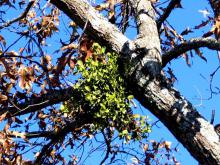Information Possibly Outdated
The information presented on this page was originally released on December 18, 2003. It may not be outdated, but please search our site for more current information. If you plan to quote or reference this information in a publication, please check with the Extension specialist or author before proceeding.
Research reveals mistletoe's roots
By Norman Winter
MSU Horticulturist
Central Mississippi Research & Extension Center
Although I don't come from a long line of kissers, many families enjoy the holiday tradition of hanging the mistletoe. Most of us probably remember running to or fleeing from the mistletoe as teenagers, depending on who happened to be under it.
While researching mistletoe, I thought I would come away with the warm fuzzies, but the tradition of hanging mistletoe has pagan roots. I do not know if it has any correlation, but it is the state flower of Oklahoma. I usually only call them pagans during football season.
Pagans, who studied Celtic druidism, used the mistletoe as a symbol of fertility, which explains why we kiss under this decoration. They also used it to keep fairies away from babies and witches from their homes. It must have really been powerful back then because they also used it as a charm against lightening and thunder.
The Victorians bound the mistletoe to a frame to make a kissing ring. Each time a gentleman caught a lady under the mistletoe, he was allowed to claim a kiss. When the branches had no more berries, the kissing had to stop. Hence the poem:
Pick a berry off the mistletoe
For every kiss that is given
When the berries have all gone
There's an end to kissing.
The church, however, was concerned over the pagan history of the mistletoe and urged instead the use of holly. The sharp, needle-like leaves represented Christ's crown of thorns, and the red berries were a symbol of His blood.
At the risk of ruining a good smooch, I'll go ahead and reveal that mistletoe is a parasite. There are people who make money selling mistletoe. I've seen it for sale in craft stores. But if you want to read about mistletoe, you go to the book called "Diseases of Trees and Shrubs." Several pages are dedicated to this affliction of our beloved trees.
Mistletoes are shrubby, photosynthetic, plant parasitic, seed plants. All are parasitic on the stems of woody plants, from which they derive water, minerals, nutrients and small amounts of organic compounds carried in the sap. In other words, they suck the life right out of that beloved oak.
The eastern mistletoe parasitizes about 110 host species in 50 genera. Host groups include ash, beech, birch, hickory, maple, oak, pecan, sycamore, walnut and willow.
The mistletoe, through a device called a sinker, becomes deeply embedded in the tree trunks. After several years they are considerably below the site of the original infection. So to remove, the branch must be cut below the mistletoe sight.
Birds spread mistletoe from tree to tree when they eat the pulp around the seeds, which stick to them. The seeds then germinate and the parasite grows through the bark into the tree's water-conducting tissues where the sinkers develop. While the seeds aren't harmful to birds, they are poisonous to humans and pets.
Merry Christmas gardeners! Tonight, as you snuggle under the mistletoe, try to forget that it's a parasite.








